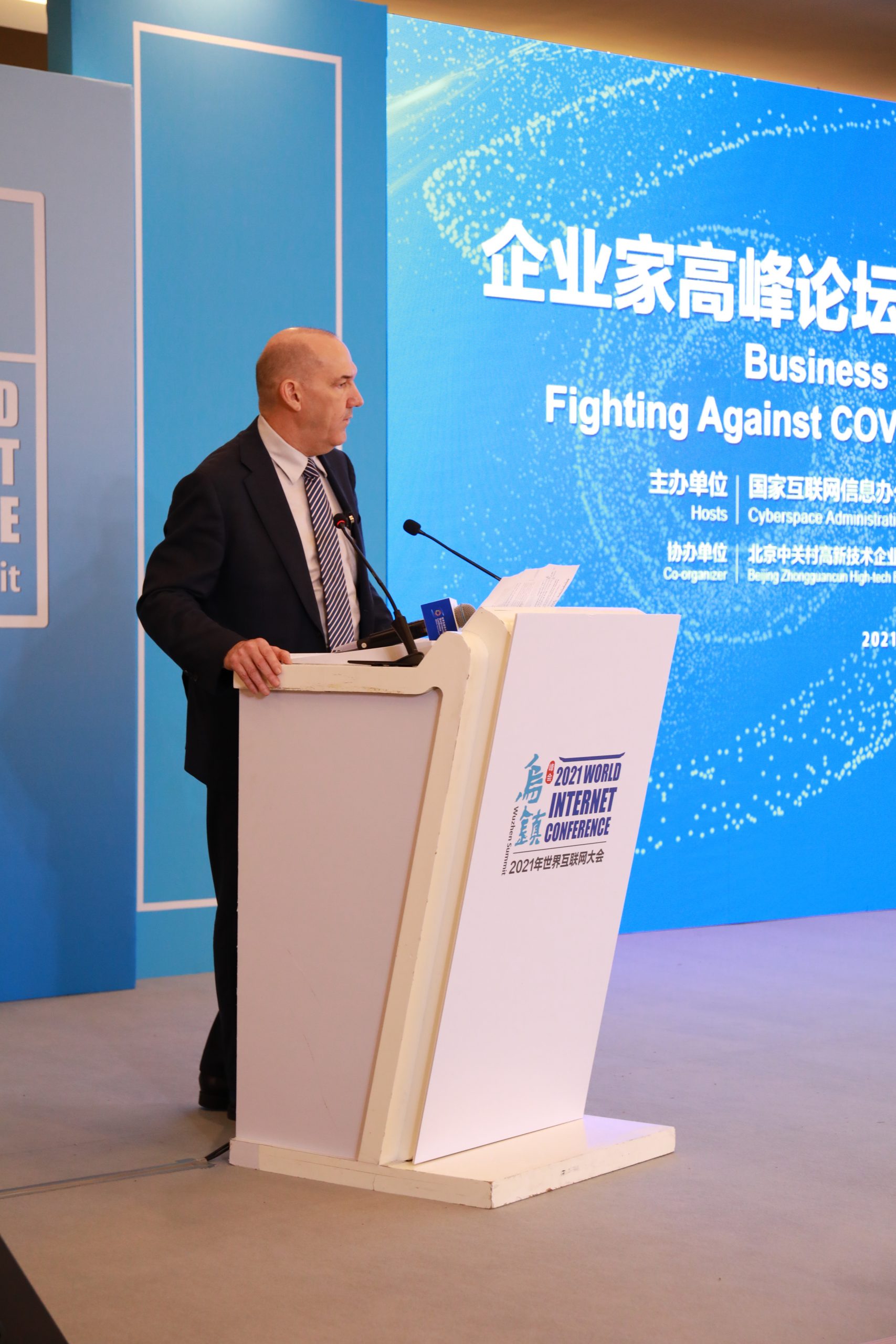Cooperation in Technology and Innovation for a Shared Global Recovery

AmCham China President Alan Beebe speaking at the 2021 World Internet Conference in Wuzhen.
Photo courtesy of the Cyberspace Administration of China
Organized annually by the Cyberspace Administration of China and Zhejiang Provincial Government, the 2021 World Internet Conference was held in Wuzhen from September 26-28. Nearly 2,000 delegates from more than 80 countries attended the Conference, either in person or virtually, including AmCham China Board members Alain Benichou (IBM) and Jian Lu (LinkedIn). The following is an abridged version of the remarks delivered at the Conference by AmCham China President Alan Beebe, who spoke in the presence of Sheng Ronghua, Vice Minister of the Cyberspace Administration of China; Xu Lejiang, Executive Vice Chairman of the All-China Federation of Industry and Commerce, and Gao Xingfu, Vice Governor of Zhejiang Province.
It is my great pleasure to attend this year’s World Internet Conference and speak here at the Business Leaders’ Dialogue alongside a great lineup of speakers from international organizations, academic institutions, and leading multinational and Chinese enterprises, and to share with you AmCham China’s perspectives on the important role technology and innovation can play in ensuring a shared global recovery.
In order for the Chamber to remain credible in the eyes of both the Chinese and US governments, AmCham China is financially independent, we advocate based on facts, and focus on supporting our members on key economic and commercial issues between the two countries. Every year, we publish the annual American Business in China White Paper that presents our collective recommendations on issues not only in our member’s interests, but also in the interests of the Chinese and US economies. It is written by our members and offers a comprehensive assessment of China’s business environment for foreign companies operating in China. This year’s 23rd edition with 535 pages is the longest in our history.
Notably, given the importance of digital technologies to nearly all of our member companies, whether in the ICT sector or others, our coverage related to digital technologies expanded considerably in this year’s White Paper. In it, members highlighted that COVID-19 continues to challenge the business community and the global economy, from the initial PPE shortages, supply chain disruptions, and the ongoing global travel restrictions. Despite China’s rapid economic recovery, COVID-related travel uncertainties remain a top business challenge for our foreign businesses, as also reemphasized in a Flash Survey we conducted just a month ago.
Strict travel restrictions imposed on businesses are leading to a more segmented global economic landscape. Our members, multinational companies operating here in China, are very significantly affected by travel restrictions, which in turn are negatively impacting their decisions to invest in China, in addition to inhibiting competitive Chinese private companies with global ambitions.
Digital Technologies and Economic Recovery
Due to COVID-19, the digital economy has become an essential front for countries and businesses to deepen cooperation as businesses and societies grow increasingly reliant on the use of digital technologies, as demonstrated by the widespread adoption of videoconferencing, remote work, and online education. As a result, according to our 2021 White Paper, digital innovation has been an especially important driver for the success of multinational companies throughout this period, with those from technology and R&D-intensive industries proving to be most successful in offsetting the negative impacts of the pandemic.
Similarly, developments in AI and Big Data, 5G, blockchain, IOT, robotics and – interestingly – digital currency and cryptocurrencies have intensified over the past year and are expected to be key economic drivers of this century. The US and China, as leaders in the development and adoption of these and other digital technologies, play a key role in leading global economic recovery.
On a personal note, I recently returned to Beijing from the US after two years in China due to travel challenges. While in the US, I was struck by the level of innovation and industrial policies sparked by COVID-19 and – to a certain extent – the US-China relationship. US technology innovation and the entrepreneurial spirit is very much alive, and in response to social inequities is being encouraged to grow in regions beyond Silicon Valley and other technology hubs to many other parts of the country.
As such, bilateral and multilateral digital cooperation is essential, as the outputs of such cooperation have ripple effects that directly impact economic competitiveness, human capital development, the ability to attract investment, and the quality of jobs in knowledge-intensive sectors.
Priority Areas for Digital Cooperation
But what exactly do we mean by digital cooperation? Let me illustrate with three relevant examples: (1) use of digital technologies to allow more open borders and safer travel between countries; (2) the adoption of digital technologies for small and medium sized companies that have been hit particularly hard by COVID-19; and (3) support for global corporations – whether US or Chinese – that are by definition global and thus require open, scalable, and cost-effective digital technologies to manage their businesses globally, across country borders. Let me elaborate on each of these three areas.
First, data and information related to COVID-19 – such as vaccination, infection locations, and travel history – are currently mostly specific to each country with limited sharing between countries. Multilateral organizations such as WHO and IATA have a vital role to play to define protocols and standards to promote seamless information sharing between countries. In the short-term, we are encouraging the US and Chinese governments to agree upon and share data and information to accelerate more open borders and safer travel between the two countries.
Second, last year we learned the hard way that many Chinese micro, small, and medium-sized enterprises were severely impacted by COVID-19 and that adopting digital technologies became essential for their survival. AmCham China understands this well since Chinese MSMEs are important business partners, suppliers, and customers of our many large corporate members; the failure of MSMEs has a significant impact on many of our large companies, across industries.
To address this challenge, AmCham China launched the Social Impact Initiative last year to foster public-private partnerships, with a focus on helping China’s MSMEs recover from the devastating economic impact of the epidemic. Facilitating digital transformation was a key theme of last year’s efforts, alongside the challenges surrounding financial inclusion and accessing markets abroad. AmCham China is grateful for the generous support we have received from both our member companies and government agencies including the Cyberspace Administration of China, the Ministry of Commerce, the Development Research Center of the State Council, as well as association such as the All-China Federation of Industry and Commerce as we continue to support MSMES in innovative ways this year, whether through training on adopting digital technologies, accessing global markets, or reducing their carbon footprints.
Third, we live in a digital age where the success or failure of companies is increasingly dependent on their use of digital technologies to maintain competitive advantage – whether by creating new digitally-enabled products and services, transforming business operations, better understanding customers, or converting data into valuable insights.
In fact, just three days ago AmCham China held our 4th annual Technology & Innovation Summit which brought together CEOs – and over 500 attendees from the US and China – to discuss and debate their China digital strategies within the context of China’s policy environment for the ICT sector and other industries such as healthcare and automotive.
In terms of policy, it is encouraging to see that China has strengthened its intellectual property protection environment and is looking to further open-up trade in services in pilot areas such as Hainan, Shanghai, and Shenzhen. Further, the signing of the US-China Economic and Trade Agreement on January 15, 2020 – otherwise known as the Phase One Trade Deal – includes provisions for China to import cloud computing parts and related services.
Challenges and Concerns
With that said, a range of policy challenges and concerns remain, such as those related to market access, the cybersecurity law, data localization, cryptography, and US and China export controls.
Beyond the roughly 100 US ICT large member companies of AmCham China, there are undoubtedly thousands of other innovative smaller US technology companies with interest in the China market that are simply not here. For them to participate in the China market, greater market access and reciprocal treatment in the telecommunications industry are absolutely necessary. Requirements for local partnerships for foreign cloud services providers, data localization and cross-border data flows, if applied more narrowly or liberalized, would be a great incentive for more foreign direct investment in China from not just technology companies, but also traditional manufacturing and services industries. In the short-term, we look forward to China further shortening the foreign investment negative list, particularly in the telecommunication sector around big data and cloud services.
Over the past few years, the biggest challenge our members face is uncertainty concerning the US-China relationship, and technology appears poised to remain at the forefront of this competitive relationship. At the same time, we see both governments increasingly turning to the use of industrial policies to boost their research and technological advances. We call on both sides to ensure that national security requirements be applied as narrowly as possible, so regular trade activities and innovation will be impacted as little as possible.
Finally, over the past few months, we have seen efforts to refine China’s Internet management framework, including legislation such as the Data Security Law, Personal Information Protection Law, Critical Information Infrastructure Protection Regulation, along with a number of draft policies seeking to address online monopolistic behaviors. AmCham China has actively worked with our members and submitted our comments to the CAC and the National People’s Congress. While efforts to protect sensitive and personal data and critical infrastructure are necessary, we at the Chamber are looking forward to sharing our ideas with regulators including the CAC to ensure regular business activities are affected as little as possible.
In closing, I would like to thank the organizers for putting together such an event where we can freely exchange observations and thoughts on the importance of cooperation in innovation and technology to support a global economic recovery. Such dialogue between a diverse group of stakeholders is critical for laying the groundwork for digital cooperation to deepen. AmCham China looks forward to engaging with regulators, business partners, and civil society actors to find solutions, and further promote digital cooperation that is good for China, the US, and the world.

This article is from the AmCham China Quarterly Magazine (Issue 3, 2021). To access the entire publication for free, sign up on our member portal here.

